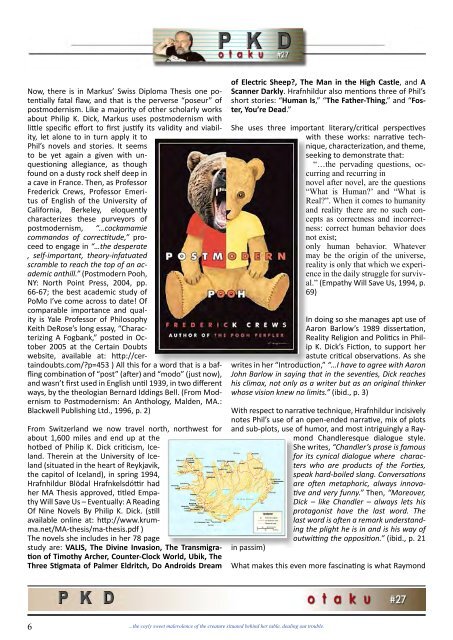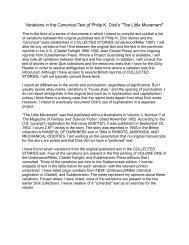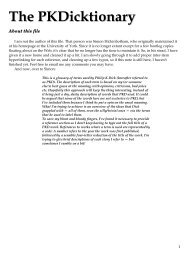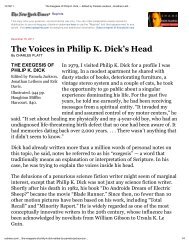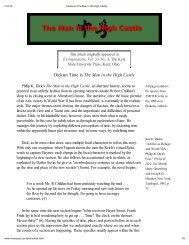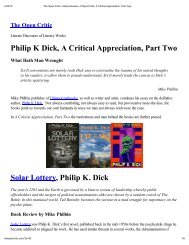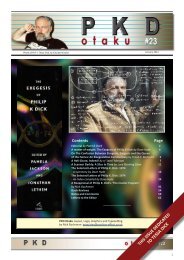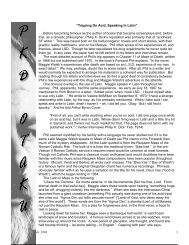PKD Otaku Issue 27 - Philip K. Dick Fan Site
PKD Otaku Issue 27 - Philip K. Dick Fan Site
PKD Otaku Issue 27 - Philip K. Dick Fan Site
Create successful ePaper yourself
Turn your PDF publications into a flip-book with our unique Google optimized e-Paper software.
Now, there is in Markus’ Swiss Diploma Thesis one potentially<br />
fatal flaw, and that is the perverse “poseur” of<br />
postmodernism. Like a majority of other scholarly works<br />
about <strong>Philip</strong> K. <strong>Dick</strong>, Markus uses postmodernism with<br />
little specific effort to first justify its validity and viability,<br />
let alone to in turn apply it to<br />
Phil’s novels and stories. It seems<br />
to be yet again a given with unquestioning<br />
allegiance, as though<br />
found on a dusty rock shelf deep in<br />
a cave in France. Then, as Professor<br />
Frederick Crews, Professor Emeritus<br />
of English of the University of<br />
California, Berkeley, eloquently<br />
characterizes these purveyors of<br />
postmodernism, “…cockamamie<br />
commandos of correctitude,” proceed<br />
to engage in “…the desperate<br />
, self-important, theory-infatuated<br />
scramble to reach the top of an academic<br />
anthill.” (Postmodern Pooh,<br />
NY: North Point Press, 2004, pp.<br />
66-67; the best academic study of<br />
PoMo I’ve come across to date! Of<br />
comparable importance and quality<br />
is Yale Professor of Philosophy<br />
Keith DeRose’s long essay, “Characterizing<br />
A Fogbank,” posted in October<br />
2005 at the Certain Doubts<br />
website, available at: http://certaindoubts.com/?p=453<br />
) All this for a word that is a baffling<br />
combination of “post” (after) and “modo” (just now),<br />
and wasn’t first used in English until 1939, in two different<br />
ways, by the theologian Bernard Iddings Bell. (From Modernism<br />
to Postmodernism: An Anthology, Malden, MA.:<br />
Blackwell Publishing Ltd., 1996, p. 2)<br />
From Switzerland we now travel north, northwest for<br />
about 1,600 miles and end up at the<br />
hotbed of <strong>Philip</strong> K. <strong>Dick</strong> criticism, Iceland.<br />
Therein at the University of Iceland<br />
(situated in the heart of Reykjavik,<br />
the capitol of Iceland), in spring 1994,<br />
Hrafnhildur Blödal Hrafnkelsdóttir had<br />
her MA Thesis approved, titled Empathy<br />
Will Save Us – Eventually: A Reading<br />
Of Nine Novels By <strong>Philip</strong> K. <strong>Dick</strong>. (still<br />
available online at: http://www.krumma.net/MA-thesis/ma-thesis.pdf<br />
)<br />
The novels she includes in her 78 page<br />
study are: VALIS, The Divine Invasion, The Transmigration<br />
of Timothy Archer, Counter-Clock World, Ubik, The<br />
Three Stigmata of Palmer Eldritch, Do Androids Dream<br />
of Electric Sheep?, The Man in the High Castle, and A<br />
Scanner Darkly. Hrafnhildur also mentions three of Phil’s<br />
short stories: “Human Is,” “The Father-Thing,” and “Foster,<br />
You’re Dead.”<br />
She uses three important literary/critical perspectives<br />
with these works: narrative technique,<br />
characterization, and theme,<br />
seeking to demonstrate that:<br />
“…the pervading questions, occurring<br />
and recurring in<br />
novel after novel, are the questions<br />
“What is Human?’ and “What is<br />
Real?”. When it comes to humanity<br />
and reality there are no such concepts<br />
as correctness and incorrectness:<br />
correct human behavior does<br />
not exist;<br />
only human behavior. Whatever<br />
may be the origin of the universe,<br />
reality is only that which we experience<br />
in the daily struggle for survival.”<br />
(Empathy Will Save Us, 1994, p.<br />
69)<br />
In doing so she manages apt use of<br />
Aaron Barlow’s 1989 dissertation,<br />
Reality Religion and Politics in <strong>Philip</strong><br />
K. <strong>Dick</strong>’s Fiction, to support her<br />
astute critical observations. As she<br />
writes in her “Introduction,” “…I have to agree with Aaron<br />
John Barlow in saying that in the seventies, <strong>Dick</strong> reaches<br />
his climax, not only as a writer but as an original thinker<br />
whose vision knew no limits.” (ibid., p. 3)<br />
With respect to narrative technique, Hrafnhildur incisively<br />
notes Phil’s use of an open-ended narrative, mix of plots<br />
and sub-plots, use of humor, and most intriguingly a Raymond<br />
Chandleresque dialogue style.<br />
She writes, “Chandler’s prose is famous<br />
for its cynical dialogue where characters<br />
who are products of the Forties,<br />
speak hard-boiled slang. Conversations<br />
are often metaphoric, always innovative<br />
and very funny.” Then, “Moreover,<br />
<strong>Dick</strong> – like Chandler – always lets his<br />
protagonist have the last word. The<br />
last word is often a remark understanding<br />
the plight he is in and is his way of<br />
outwitting the opposition.” (ibid., p. 21<br />
in passim)<br />
What makes this even more fascinating is what Raymond<br />
6 ...the coyly sweet malevolence of the creature situated behind her table, dealing out trouble.


